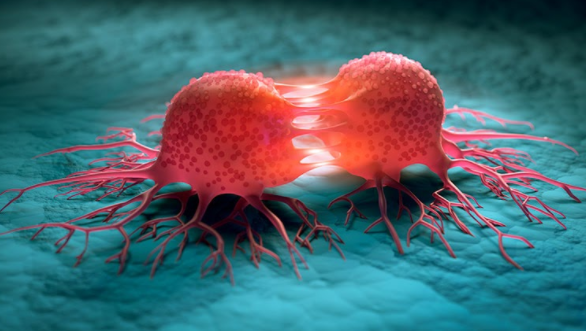Cancer Cells
- STEM To Go

- Apr 4, 2021
- 4 min read
What is cancer? How does one develop cancer? Is there any treatment or cure? Read more to find out.
Cancer is a non-communicable disease that means you cannot be infected if you’ve interacted with someone who was diagnosed. Cancer was placed at the 2nd highest leading cause of death after heart disease. Cancer cells develop when there is irregular activity occurring during cell division. In simple terms, if the cell cycle accelerates, the cells will develop into a tumor. Abnormal cell division can be caused by genetics, environmental factors, radiation, and more. One in two American men and one in three American women are diagnosed with the disease. The cancer rate since 1991 has decreased tremendously, but the cancer death rate has increased.

How does the cell cycle produce cancer cells?
Cells need to reproduce when there is a gap, reproduction, or if there is an injury. The cycle consists of many checkpoints to make sure the cells have the right resources to enter each stage correctly. The first is to make sure the cells are growing big enough and have the right resources to be replicated. If the cells do not, they will move to G0, where they do nothing. The second is to make sure the DNA is replicated correctly, and if so the cells can move onto mitosis, which is cell division. The last checkpoint occurs during metaphase, where it checks to make sure all the chromosomes are lined up straight across the metaphase plate and the spindle fibers are attached. However, sometimes a mutation occurs. Cancer starts with a DNA mutation, during DNA replication, or there might be an error with base pairings. In these cases, there will either be an extra, missing, or moved DNA molecule. It is important to note that not all mutations cause cancer. Location of the mutation determines if it will become a cancerous cell or not. If the mutation is in the proto-oncogene, tumor suppressor, or DNA editing gene, then it becomes dangerous. The proto-oncogene is responsible for accelerating the cell cycle and produces proteins to accelerate to the next stage. If this gene ever becomes mutated, cell division will happen too quickly, and the tumor suppressor won’t be able to stop. The tumor suppressor sends stop signals to either stop or slow down the cycle. If the tumor suppressor becomes mutated, there will be no brake to slow down the proto-oncogene, causing rapid cell division. If the DNA becomes mutated, it will cause the proto-oncogene to turn into an oncogene, which stands for cancer. As the cycle continues to speed up, from division every four days to every day, mutations happen more frequently. Your skin has the highest exposure to sunlight; your skin cells are considered to be cells that generally need to be replaced.
What causes cancer?
As mentioned, cancer is caused by rapid cell division; the cells grow too fast and develop a tumor. Genetics play a huge role. If your parents are carrying a variant of the gene, it will most likely be passed down to you too. The cancer gene can be passed down generations. Ultraviolet radiation also leads to an increased rate of cancer, especially skin cancer. Smoking has chemicals that can affect your lungs and cause lung cancer. Obesity is also an important factor, since having extra fat causes inflammation. Inflammation leads to a mass production of insulin and estrogen, which leads to cancer cells. Viruses can also increase the chances of developing cancer; it’s essential to stay safe and healthy. There are many ways you can reduce the chances of developing cancer.
Are there treatments or cures?
Many people might have the same cancer type, but the cancer will never be identical because it is mutating and evolving every second. This is why finding a cure or treatment for cancer is complex. Studies on cancer revealed that there are only 200 essential genes that cause cancer, and those genes fondle down to 12 pathways. This is why gene mapping is vital to finding a cure to cancer. A cancer patient would need to be injected with multiple drugs because not every drug will be affected, but having more drugs will leave a higher chance of one being affected. Scientists would be able to treat each cancer patient with their personalized combination of drugs. Currently, ongoing research and clinical trials are being conducted to find treatments for cancer. There are many treatments: chemotherapy, radiation therapy, surgery, and more. However, none of these treatments guarantees a person will be cancer-free. Some clinical trials performed by doctors have found that inserting a lab-made virus into the body can kill cancer cells. The virus only attacks the cancer cells and will not affect the patient’s health. Leukemia clinical trials have also been proven to be effective when a patient is injected with the HIV virus. T cells would then be able to determine and mark which cells were cancer cells allowing the white blood cells to do their job. There has been a high success rate with this method. Who knows what discoveries will be made in the future.
Thank you for reading!
Written by: Amber Truong
Sources:
Cancer develops resistance to our most lethal drugs. Now we know how. (2020, June 9). NewsGP. https://www1.racgp.org.au/newsgp/clinical/cancer-develops-resistance-to-our-most-lethal-drug
Causes. (2017, September 12). Stanford Health Care. https://stanfordhealthcare.org/medical-conditions/cancer/cancer/cancer-causes.html




Comments